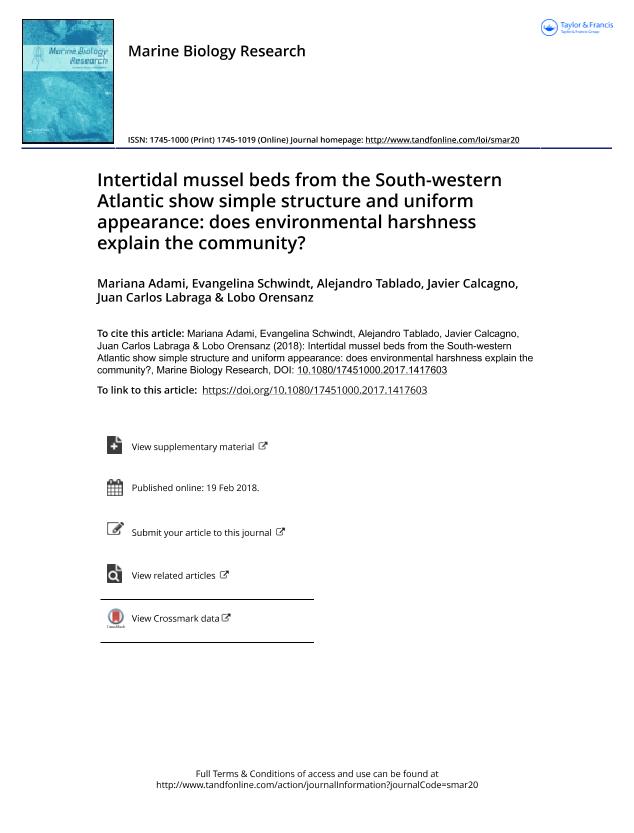Artículo
Intertidal mussel beds from the South-western Atlantic show simple structure and uniform appearance: does environmental harshness explain the community?
Adami, Mariana Laura ; Schwindt, Evangelina
; Schwindt, Evangelina ; Tablado, Alejandro
; Tablado, Alejandro ; Calcagno, Javier Ángel
; Calcagno, Javier Ángel ; Labraga, Juan Carlos
; Labraga, Juan Carlos ; Orensanz, Jose Maria
; Orensanz, Jose Maria
 ; Schwindt, Evangelina
; Schwindt, Evangelina ; Tablado, Alejandro
; Tablado, Alejandro ; Calcagno, Javier Ángel
; Calcagno, Javier Ángel ; Labraga, Juan Carlos
; Labraga, Juan Carlos ; Orensanz, Jose Maria
; Orensanz, Jose Maria
Fecha de publicación:
04/2018
Editorial:
Taylor & Francis As
Revista:
Marine Biology Research
ISSN:
1745-1000
Idioma:
Inglés
Tipo de recurso:
Artículo publicado
Clasificación temática:
Resumen
Communities of the rocky mid-intertidal zone of the South-western Atlantic are uniform in appearance, dominated by dense monocultures of small-size mussels (Brachidontes rodriguezii and Perumytilus purpuratus). To explain this, two hypotheses have been advanced in the literature: environmental harshness due to high potential evaporation and historical contingency after the Last Glacial Maximum. In this study of Uruguayan and Argentine shores, we address the implications and predictions of these two hypotheses from a biogeographic perspective by studying the regional distribution and composition of mid-intertidal mussels. We conducted an extensive latitudinal sampling survey (21 locations, 34–54°S), along with a compilation of available information on mussel bed composition and mussel predators present along the coastline. Then we constructed latitudinal profiles of ecologically significant environmental variables with specific emphasis on potential evaporation, a proxy for desiccation stress. The results show that mussel beds are composed of two species of small mussels, which coexist over a biogeographic transition zone (40–42°S) related to sea surface water temperature. The distribution of mussels along the coastline studied is not consistent with the environmental harshness hypothesis. In addition, in the Central Patagonian zone (44–50°S), two invertebrate predators also inhabit the intertidal rocky shores. However, these localities showed higher environmental harshness (potential evaporation rate) than non-Patagonian localities. We suggest that further attention should be given to historical contingency in order to advance towards a hypothesis consistent with current knowledge on the post-glacial biogeographic history of the South-western Atlantic.
Palabras clave:
Historical Contingency
,
Mussel Bed
,
South-Western Atlantic
,
Stress
Archivos asociados
Licencia
Identificadores
Colecciones
Articulos(CCT - LA PLATA)
Articulos de CTRO.CIENTIFICO TECNOL.CONICET - LA PLATA
Articulos de CTRO.CIENTIFICO TECNOL.CONICET - LA PLATA
Articulos(MACNBR)
Articulos de MUSEO ARG.DE CS.NAT "BERNARDINO RIVADAVIA"
Articulos de MUSEO ARG.DE CS.NAT "BERNARDINO RIVADAVIA"
Articulos(SEDE CENTRAL)
Articulos de SEDE CENTRAL
Articulos de SEDE CENTRAL
Citación
Adami, Mariana Laura; Schwindt, Evangelina; Tablado, Alejandro; Calcagno, Javier Ángel; Labraga, Juan Carlos; et al.; Intertidal mussel beds from the South-western Atlantic show simple structure and uniform appearance: does environmental harshness explain the community?; Taylor & Francis As; Marine Biology Research; 14; 4; 4-2018; 403-419
Compartir
Altmétricas



